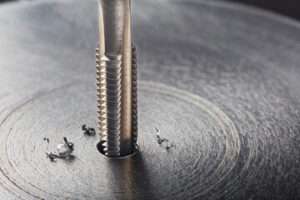 In the world of metalworking and manufacturing, threading is a crucial process that involves creating helical grooves on the inside or outside of a cylindrical surface. This enables the joining of parts through the use of fasteners like screws and bolts. Thread tapping and thread form tapping are two common methods employed for this purpose. Each method has its advantages and applications, and choosing the right one depends on various factors such as material, tolerance, and desired thread characteristics.
In the world of metalworking and manufacturing, threading is a crucial process that involves creating helical grooves on the inside or outside of a cylindrical surface. This enables the joining of parts through the use of fasteners like screws and bolts. Thread tapping and thread form tapping are two common methods employed for this purpose. Each method has its advantages and applications, and choosing the right one depends on various factors such as material, tolerance, and desired thread characteristics.
Thread Tapping:
Thread tapping is a traditional method of creating threads in a pre-drilled hole. The process involves using a tap, a cutting tool with a series of teeth, to remove material and form the thread. There are several types of taps, including hand taps, machine taps, and spiral flute taps, each designed for specific applications.
Advantages of Thread Tapping:
Versatility: Thread tapping can be used on a wide range of materials, including metals, plastics, and composites.
Precision: Thread tapping allows for precise control over thread dimensions and tolerances, making it suitable for applications where accuracy is crucial.
Ease of Use: Thread tapping is relatively straightforward, and it can be performed manually or with the help of automated machinery.
Thread Form Tapping:
Thread form tapping, on the other hand, is a more modern approach to threading. This method doesn’t involve cutting material like traditional tapping but instead deforms the material to create threads. The tool, known as a thread form tap, has lobes that displace material into the desired thread shape without creating chips.
Advantages of Thread Form Tapping:
Increased Tool Life: Since thread form tapping doesn’t produce chips, the tool experiences less wear and tear, leading to longer tool life.
High Production Rates: Thread form tapping is well-suited for high-speed tapping operations, making it a preferred choice for mass production.
Reduced Friction: The deformation process generates less friction compared to cutting, resulting in lower torque requirements and energy consumption.
Choosing Between Thread Tapping and Thread Form Tapping:
The decision between thread tapping and thread form tapping depends on several factors:
Material: Thread form tapping is generally more suitable for ductile materials like aluminum and soft metals, while thread tapping is versatile and can be used on a broader range of materials.
Production Volume: For high-volume production, thread form tapping may be more efficient due to its faster cycle times and extended tool life.
Thread Quality: Thread tapping provides superior control over thread dimensions and may be preferred in applications where tight tolerances are crucial.
Tooling Costs: Thread form taps may initially be more expensive, but their longer tool life can result in cost savings over time, especially in high-production scenarios.
Conclusion:
Both thread tapping and thread form tapping are valuable methods for creating threads in various materials. The choice between them depends on specific application requirements, production volume, and material characteristics. Manufacturers should carefully evaluate these factors to determine the most suitable threading method for their needs, ultimately achieving optimal efficiency and product quality.